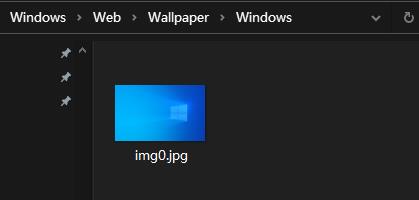Where is the Win11 background image stored?
Dec 27, 2023 am 11:59 AMThe win11 system has updated a lot of new wallpapers for everyone, so many users will be curious about which folder the win11 wallpapers are in, and want to open them to see the wallpapers inside, so we have brought a tutorial so that you can Enter to view wallpapers.
Which folder is the win11 wallpaper in:
1. The system comes with wallpaper:
1. First enter my computer, and then open the path: C:\Windows\ Web\Wallpaper.

2. Then enter the windows folder and you can see the wallpaper that comes with the system.

2. User-saved wallpapers:
1. Wallpapers installed by users will be saved in:
C:\Users( user)\xx (current username)\AppData\Local\Microsoft\Windows\Themes.
2. Just open My Computer and enter the path in order to see the wallpaper you saved.

The above is the detailed content of Where is the Win11 background image stored?. For more information, please follow other related articles on the PHP Chinese website!

Hot AI Tools

Undress AI Tool
Undress images for free

Undresser.AI Undress
AI-powered app for creating realistic nude photos

AI Clothes Remover
Online AI tool for removing clothes from photos.

Clothoff.io
AI clothes remover

Video Face Swap
Swap faces in any video effortlessly with our completely free AI face swap tool!

Hot Article

Hot Tools

Notepad++7.3.1
Easy-to-use and free code editor

SublimeText3 Chinese version
Chinese version, very easy to use

Zend Studio 13.0.1
Powerful PHP integrated development environment

Dreamweaver CS6
Visual web development tools

SublimeText3 Mac version
God-level code editing software (SublimeText3)

Hot Topics
 Problem-Solving with Python: Unlock Powerful Solutions as a Beginner Coder
Oct 11, 2024 pm 08:58 PM
Problem-Solving with Python: Unlock Powerful Solutions as a Beginner Coder
Oct 11, 2024 pm 08:58 PM
Pythonempowersbeginnersinproblem-solving.Itsuser-friendlysyntax,extensivelibrary,andfeaturessuchasvariables,conditionalstatements,andloopsenableefficientcodedevelopment.Frommanagingdatatocontrollingprogramflowandperformingrepetitivetasks,Pythonprovid
 Unleash Your Inner Programmer: C for Absolute Beginners
Oct 11, 2024 pm 03:50 PM
Unleash Your Inner Programmer: C for Absolute Beginners
Oct 11, 2024 pm 03:50 PM
C is an ideal language for beginners to learn programming, and its advantages include efficiency, versatility, and portability. Learning C language requires: Installing a C compiler (such as MinGW or Cygwin) Understanding variables, data types, conditional statements and loop statements Writing the first program containing the main function and printf() function Practicing through practical cases (such as calculating averages) C language knowledge
 Python Power, Simplified: A Beginner-Friendly Approach to Programming
Oct 11, 2024 pm 04:53 PM
Python Power, Simplified: A Beginner-Friendly Approach to Programming
Oct 11, 2024 pm 04:53 PM
Getting Started with Python Programming Install Python: Download and install from the official website. HelloWorld!: Use print("HelloWorld!") to print the first line of code. Practical case: Calculate the area of ??a circle: Use π (3.14159) and the radius to calculate the area of ??the circle. Variables and data types: Use variables to store data. Data types in Python include integers, floating point numbers, strings, and Boolean values. Expressions and assignments: Use operators to connect variables, constants, and functions, and use the assignment operator (=) to assign values ??to variables. Control flow: if-else statement: execute different code blocks based on conditions, determine odd
 The Key to Coding: Unlocking the Power of Python for Beginners
Oct 11, 2024 pm 12:17 PM
The Key to Coding: Unlocking the Power of Python for Beginners
Oct 11, 2024 pm 12:17 PM
Python is an ideal programming introduction language for beginners through its ease of learning and powerful features. Its basics include: Variables: used to store data (numbers, strings, lists, etc.). Data type: Defines the type of data in the variable (integer, floating point, etc.). Operators: used for mathematical operations and comparisons. Control flow: Control the flow of code execution (conditional statements, loops).
 Demystifying C: A Clear and Simple Path for New Programmers
Oct 11, 2024 pm 10:47 PM
Demystifying C: A Clear and Simple Path for New Programmers
Oct 11, 2024 pm 10:47 PM
C is an ideal choice for beginners to learn system programming. It contains the following components: header files, functions and main functions. A simple C program that can print "HelloWorld" needs a header file containing the standard input/output function declaration and uses the printf function in the main function to print. C programs can be compiled and run by using the GCC compiler. After you master the basics, you can move on to topics such as data types, functions, arrays, and file handling to become a proficient C programmer.
 Create the Future: Java Programming for Absolute Beginners
Oct 13, 2024 pm 01:32 PM
Create the Future: Java Programming for Absolute Beginners
Oct 13, 2024 pm 01:32 PM
Java is a popular programming language that can be learned by both beginners and experienced developers. This tutorial starts with basic concepts and progresses through advanced topics. After installing the Java Development Kit, you can practice programming by creating a simple "Hello, World!" program. After you understand the code, use the command prompt to compile and run the program, and "Hello, World!" will be output on the console. Learning Java starts your programming journey, and as your mastery deepens, you can create more complex applications.
 Java Made Simple: A Beginner's Guide to Programming Power
Oct 11, 2024 pm 06:30 PM
Java Made Simple: A Beginner's Guide to Programming Power
Oct 11, 2024 pm 06:30 PM
Java Made Simple: A Beginner's Guide to Programming Power Introduction Java is a powerful programming language used in everything from mobile applications to enterprise-level systems. For beginners, Java's syntax is simple and easy to understand, making it an ideal choice for learning programming. Basic Syntax Java uses a class-based object-oriented programming paradigm. Classes are templates that organize related data and behavior together. Here is a simple Java class example: publicclassPerson{privateStringname;privateintage;
 The Keys to Coding: Unlocking the Power of C for Beginners
Oct 13, 2024 am 11:44 AM
The Keys to Coding: Unlocking the Power of C for Beginners
Oct 13, 2024 am 11:44 AM
C language, as the basis of programming, opens the door to programming for beginners with its efficiency and versatility. Its simple syntax consists of keywords, identifiers, data types and operators. Variables are used to store data, and the data type determines the scope of the variable. Operators operate on data and expressions are used to calculate values. Control flow statements control the order of program execution, including if, for, and while loops. Functions are reusable blocks of code that accept parameters and return values. In the actual case, the C language program can calculate the area of ??a circle, read the radius and use the formula to calculate the area, and output the result.






